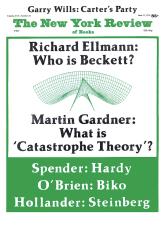In response to:
Animal Babel from the March 9, 1978 issue
To the Editors:
In an otherwise informed review of Sebeok’s How Animals Communicate (NYR, March 9) J. Z. Young conflates the distinction between information transfer and communication proper. For example, when he says that “every cell of every organism is controlled by the operations of what can only be called a set of instructions embodied in an elaborate code,” he is playing on the word “instructions.” To be sure, there is an intricate, systematic correlation between genetic structure and biochemical activity but this does not mean “these instructions are read and copied by processes that are justly called transcription and translation.” Even granting that the genetic code is a symbol system rather than merely a system of causal correlations, to speak of “communication” here is at best pickwickian. The same goes for Young’s description of the gyrations of bees as constituting “an argument about which site is best.”
However subtle and complex the symbol system used, information transfer qualifies as communication only if the source (e.g., speaker) has a certain kind of complex intention directed toward the recipient (e.g., addressee). Communication is essentially the expression of an attitude, such as a belief (in the case of statements) or a desire (in the case of requests). To express an attitude one intends the recipient to regard what one is doing (e.g., saying something) as reason to believe one has that attitude. Communication succeeds only if the recipient recognizes this intention (whether the source actually has the attitude expressed is another matter, inasmuch as deceit is always possible). Thus, genuine communication can take place only between beings who not only have intentions and beliefs but can have and can recognize intentions of this complex sort. And this is possible only if each communicant is not only aware of the other but aware that the other is aware of him. Surely this is beyond the capacity of almost all animals.
The above conception of communication, originating with H.P. Grice (“Meaning,” Philosophical Review, 1957), has undergone various formulations, including a forthcoming one of my own. Young’s ignorance of these philosophical developments yields a blurring of the distinction between transmitting information, something clocks and radios can do much better than bees, and genuine communication. He is right to emphasize the diversity of symbolic and representational systems in the animal kingdom, but just as it is a mistake to regard clocks as telling us the time or alarms as telling us to wake up, so Young is wrong to assume that every use of any such system is communicative.
Kent Bach
Department of Philosophy
San Francisco State University
San Francisco, California
J.Z Young replies:
If Dr. Bach’s views about what is right and wrong in use of language prevailed then human communication would remain trapped forever in the current use of words. He obviously is not up to date with biological developments. The distinctions he wishes to make are ignored every day by tens of thousands of geneticists and molecular biologists as they chatter about the transcription and translation of the instructions in the genetic code.
I am well aware that some philosophers would like to restrict the concept of “true” communications to those that are backed by human intention. There is indeed much to be said for giving technical meanings to words, if they refer to easily distinguishable entities. So the question is—are human “intentions” so absolutely distinct that only they can usefully be regarded as the basis for “true” communication? Dr. Bach clearly thinks “yes,” and others would agree with him. They are entitled to try to persuade us that man is so totally different from the rest of creation that a separate language should be reserved for him. Biologists think otherwise. Indeed while recognising the marvel of man, some of us think that all life is about equally wonderful and that it merits a unified language and a common respect.
Let the controversy continue.
This Issue
June 15, 1978



